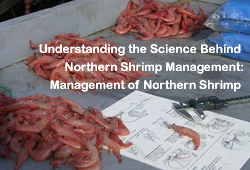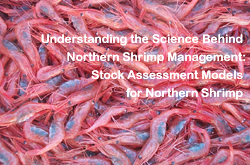Fisheries Science 101
Marine fisheries management is a complex process incorporating fisheries biology and stock status information, food web and predator/prey relationships, habitat needs, socioeconomic needs of recreational and commercial fishermen, and law enforcement issues. The Commission develops and uses rigorous, comprehensive science to inform fisheries management decision-making to ensure healthy, sustainable fisheries.
The fisheries science concepts described below give stakeholders a better understanding of the types of information scientists provide to fishery managers.
For more detailed information, download our Guide to Fisheries Science and Stock Assessments.
What is a Fish Stock?
Fish populations do not adhere to the political boundaries drawn by people. Instead, their ranges are defined by environmental preferences and tolerances. For example, freshwater versus marine, tropical versus temperate regions, or estuaries versus open ocean habitats. Species such as Atlantic sturgeon and American shad are found up and down the Atlantic coast, from Maine to Florida. Other species, like northern shrimp prefer colder waters of the Gulf of Maine and Polar Regions.
A fish population is a biological unit referring to individuals of a species living in the same area.
A fish stock is a management unit grouped by genetic relationship, geographic distribution, and movement patterns.
For example, northern shrimp in the U.S. portion of the Gulf of Maine are considered a separate stock, even though northern shrimp are also found in Canadian and European waters. Because northern shrimp in the Gulf of Maine do not mix with northern shrimp in other areas, factors that affect the population of northern shrimp in the Gulf of Maine, like temperature, predation, and fishing pressure, do not affect other populations of shrimp in other areas.
Why Assess Fish Stocks?
The Commission assesses fish stocks to 1) determine their status, 2) evaluate how stocks have been affected by management actions, and 3) forecast future conditions, including under various potential management actions.
In fisheries, determining stock status means determining whether the stock is large enough to sustain itself at current fishing levels, or whether we are fishing it too hard. If the abundance (numbers of fish) or biomass (weight) is below a sustainable reference point, often called a threshold, the stock is considered overfished. Conversely, if abundance or biomass is above the threshold, the stock is not overfished. Overfishing is not occurring if the rate of fishing (i.e., exploitation or fishing mortality) is below a sustainable reference point. However, if exploitation or fishing mortality is above the threshold, overfishing is occurring.
Management actions are typically measures to stop overfishing when it occurs and rebuild stocks considered overfished. Management also strives to avoid overfishing and prevent viable stocks from becoming overfished. Forecasts, or projections, are an important part of the management program used to set future catch levels, evaluate alternative management strategies, and establish timeframes for rebuilding overfished stocks or protecting healthy stocks.
Data Sources for Stock Assessment
There are two types of data used in stock assessment: fishery-dependent data and fishery-independent data.
What are fishery-dependent data?
Fishery-dependent data are collected from commercial sources (fishermen or dealer reports) and recreational sources (individual anglers, party or charter boats). Information is gathered on the total amount of fish removed from the ocean (landings and dead discards) and the level of fishing participation (effort). Additionally, information is collected about the fishing trip itself – who, what (target species), when (season), where (location) and how (gear type); related economic information (the cost of fishing trips, the value of fish sold); and biological information (species, age, length, weight, maturity of fish caught in a fishery). In some cases, information is also gathered on fishing gear interactions with protected species (marine mammals, sea turtles, and sea birds), bycatch of non-target species, and discards – fish returned to the sea dead or alive.
What are fishery-independent data and why are they collected?
Fishery-independent data are collected by scientists conducting long-term resource monitoring projects known as fishery-independent surveys. These surveys are specifically designed to follow consistent methods using the same gear for the duration of the survey in order to develop unbiased and independent indices of abundance. State, federal, and university scientists typically conduct fishery-independent surveys over many years to track long-term abundance trends of fishery resources. These data, when combined with fishery-dependent data from fishermen reports, provide a more accurate picture of stock status. Since the data are not influenced by specific management measures (size and bag limits, season closures, mesh sizes) or socioeconomic factors, they present an unbiased accounting of stock health. These surveys often collect biological data and other information used to describe juvenile and adult abundances, fish habitat characteristics, and environmental factors.
For more information of fishery-independent surveys, visit the following program pages for NEAMAP, SEAMAP and Surveys.
Life History Information
Life history characteristics play an important role in the management and assessment of a species. They provide information on how productive and resilient a species may be and how much harvest they can sustain. Examples of life history questions that provide important information to both the general understanding of the species’ biology and stock assessments are provided in the table below.
|
Life History Parameters |
Management & Assessment Uses |
|
How long does it live? |
To estimate natural mortality and set maximum age in assessment models |
|
How large does it grow? |
To set size limits and estimate total biomass |
|
How fast does it grow? |
Implications as to how fast it will reach the fishery’s minimum size limit |
|
Where does it live? |
Identifies habitat needs and areas to protect |
|
What is the age of first spawning? |
To establish minimum size limits to ensure species reproduce at least once prior to being harvested |
|
When, where, and how does it spawn? |
Identifies areas and times of increased vulnerability to harvest; may lead to seasonal closures to protect spawning aggregations or specific habitat types |
|
How many eggs are produced? |
Helps to determine the reproductive capacity of the stock as well as develop egg per recruit estimates |
|
How does it develop and what habitats does it rely on? |
Identifies important habitats to protect during vulnerable life stages |
|
What does it eat? How does it eat? What eats it? |
Predator/prey, food web, and species interactions; multispecies and ecosystem management |
A couple of ways scientists collect life history information is through the measurement of length and weigh and assessing age by growth marks on hard structures such as the ear bone (otolith). Combined, these data help scientists determine length at age, a key variable in stock assessments.
Stock Assessments
Population concepts
Fisheries stock assessments involve characterizing and predicting the changes in a fish population over time. Population size is determined by the amount of new individuals coming in, new growth in the weight of existing individuals, and the amount of individuals removed from the population. In essence, birth and growth add to the population and death subtracts from the population. The goal of a fisheries stock assessment is to measure, or assess, the magnitude of additions and subtractions in order to estimate stock size.
Recruitment is the number of fish born within a given time period that survive to the juvenile stage. It is typically described in terms of ‘annual recruitment’, the number of survivors in each year, also known as a ‘cohort’ or ‘year-class’. Mortality is the number of fish dying within a given time period either from fishing activities (fishing mortality) or natural causes like predation or disease (natural mortality). The net impact of recruitment and mortality determines the overall population abundance, the number of fish alive at a particular time. Growth in the population occurs as fish increase their lengths and weights. Growth influences the total population biomass (the total weight of all fish alive at a particular time). Although recruitment, mortality, and growth may differ among species, for any population these basic elements apply. As births occur, the population increases in numerical abundance. With new growth, the population increases in weight. As deaths occur, the population decreases in number and in weight. In most stock assessments, we assume the population is closed (i.e., there is no emigration or immigration).
Stock assessment models
|
Assessment Model Type |
Species |
|
Trend Analyses |
American Eel American Shad Atlantic Croaker Atlantic Sturgeon Horseshoe Crab |
|
Statistical Catch-at-Length |
American Lobster |
|
Surplus Production Model |
Small & Large Coastal Sharks |
|
Statistical Catch-at-Age |
Atlantic Herring Atlantic Menhaden Atlantic Striped Bass Black Sea Bass Bluefish |
| Ecosytem Models |
Atlantic Menhaden |
A stock assessment model is a set of equations used by stock assessment scientists to estimate the size of a stock and the exploitation rate experienced by that stock using the available fishery dependent, independent, and life history information. Due to large differences among fish species, fisheries, and data collected, no single modeling approach will provide the best answer for all stocks; therefore, a variety of assessment models and analyses have been developed.
The primary types of assessment approaches include trend analyses and statistical catch-at-age models. Trend analyses are the simplest approach often applied in data-poor situations; these analyses describe changes over time in a stock, but cannot provide estimates of the magnitude of stock size of mortality rates. Surplus production models use total landings and survey data to provide total stock biomass or abundance estimates, estimates of fishing mortality, and estimates of sustainable yield, but they do not differentiate among fish of different cohorts (age classes). Virtual population analysis and statistical catch-at-age approaches are age-structured models that track changes in each cohort of fish over time and provide estimates of abundance and fishing mortality for each age class annually. The table below contains a list of common stock assessment models and the ASMFC species that use these models as their primary or supplementary assessment tools.
For more details on these models and their components, download our Guide to Fisheries Science and Stock Assessments. Also, you may wish to consult our short introduction to forward and backward age-structured models.
Integration into Management
Reference Points and Stock Status
Stock assessments attempt to characterize the overall state, or status, of a stock by providing information about the level of mortality a fish population can sustain without negatively affecting stock size, recruitment, and growth of the population. During a stock assessment, management tools called reference points are generated that compare the current mortality rate and abundance of the stock relative to the life history of the fish and management objectives for the stock. Reference points typically allow managers to make at least two statements about stock status, namely overfishing and overfished declarations. Overfishing is said to be occurring if fishing is negatively affecting the stock by removing more fish than the stock can sustain, leading to reduced growth and/or recruitment. A stock is said to be overfished or depleted if the stock has reached critically low biomass or abundance. Overfished is used when fishing mortality is the primary cause of low biomass or abundance, while depleted is used when it is uncertain if fishing mortality or other factors such as habitat loss or environmental changes are the primary cause of low biomass or abundance. Managers use stock assessment results, reference points, and stock status declarations to determine the appropriate management measures to adopt in order to ensure healthy, self-sustaining stocks.
Various references have been developed to bridge the gap between management needs and the often-limited data for a given stock. For examples of typical reference points used in fisheries management, download Development and Use of Reference Points.

.jpg)
.jpg)

.jpg)
.jpg)